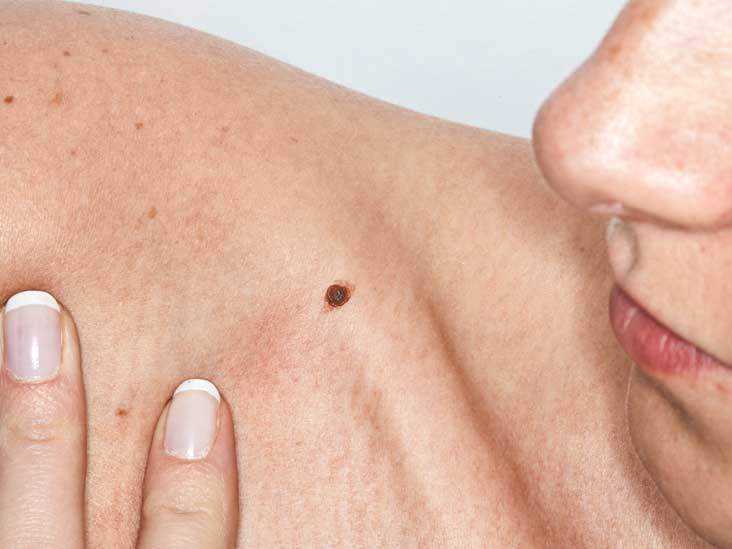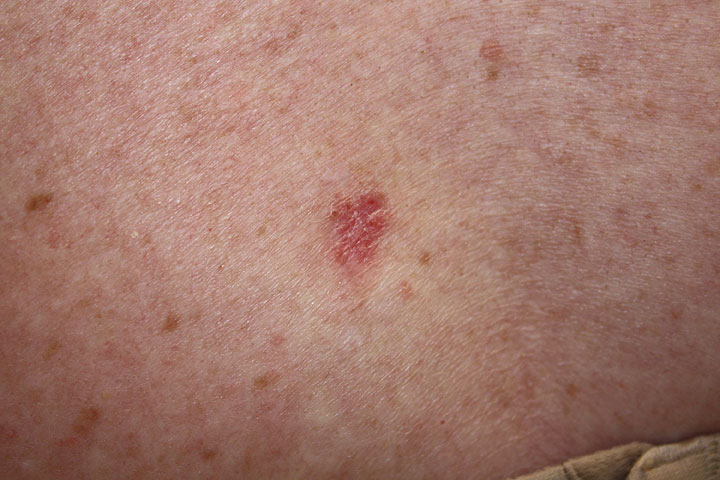Table of Contents
A basal cell carcinoma is a common form of cancer that develops on the surface of the skin. Most of the times, it is characterized by a crusted papule.
Basal cell carcinoma is one of the most common cancers prevalent among fair skin people, affecting about 3 out of 10 Caucasians around 50 years of age. Its development is in sync with exposure to sunlight and ultraviolet radiation.
The skin is subject to three types of cancer:
Squamous cell carcinoma, melanoma, and basal cell carcinoma. Basal cell carcinoma, which develops from cells of the epidermis, is the most common form of skin cancer, with 800.000 new cases reported every year in the United States.
While other parts of the body may be affected by a tumour, basal cell carcinoma occurs mainly on sun-exposed skin areas, primarily the head and neck. Unlike other types of cancer, most basal cell carcinomas are effectively treated by surgery with a low risk of recurrence when detected early. However, if left untreated, the tumour can develop rapidly and lead to destructive expansion, particularly in the face. Basal cell carcinomas barely lead to the development of metastases.
1. Causes.
You develop basal cell carcinoma when the cells of the outermost layer of your skin multiply abnormally. Most common factors that can cause skin cells to mutate and become cancerous include:
-
UV Rays and Sunburn.
Basal cell carcinoma develops from cells in the epidermis, mostly the epidermal cells of head and neck. A tumour develops most often on parts of the body that are exposed to sunlight. This is why people who are ostensibly exposed to sunlight are susceptible of skin cancers, including basal cell carcinoma. Therefore, chronic exposure to UV radiation and frequent sunburns are considered as the two major risk factors of basal cell carcinoma.
-
Chronic exposure to certain chemicals.
Environmental factors such as certain herbicides, some petroleum products, arsenic exposure, may contribute to the development of basal cell carcinoma and other cancers.
-
Inherited disorders.
Certain genetic medical conditions such as albinism, Gorlin’s syndrome (nevoid basal cell carcinoma syndrome), Bazex’s syndrome and xeroderma pigmentosum are found to increase the risk of basal cell carcinoma.
-
Immunosuppressive medications.
Prolong use of agents or drugs that inhibit or weaken the immune system can lead to not only basal cell carcinoma but other types of cancers.
-
Chronic wounds.
Chronic skin ulcers or wounds may contribute to the occurrence of basal cell carcinoma.
2. People at Risk of Basal Cell Carcinoma.
Basal cell carcinoma can affect people of any gender, race or medical history; however, you are more likely to have basal cell carcinoma, if you fall into one of these groups:
- People who have white skin, blue or green eyes, and blond hair.
- Patients who have a history of melanoma or squamous cell carcinoma.
- People who have suffered a significant sun exposure for several years, especially during childhood.
- Patients who have been exposed to ionizing radiation or ultraviolet light for therapeutic or professional reasons.
- People who have been in contact with chemical preparations that include more than 5 per cent of crude coal tar.
- People who received cancer treatment such as chemotherapy or radiotherapy.
- People who have undergone immunosuppressive therapy due to specific medical reason such as heart or kidney transplant.
- People who have scars from severe burns.
- People who have many moles.
- People who have actinic keratosis – scaly or crusty bumps that develop on the skin surface.
- People aged over 50 years.
- People living at high altitudes or near the South Pole such as Australia.
- People who work outdoors and are regularly exposed to sun rays: farmers, construction workers.
- People who have weakened immune systems such as HIV victims, cancer patients, and those who had an organ transplant.
- People who work as a welder, Boilermaker or printer.
3. Symptoms.
Basal cell carcinoma manifests most often in the form of a white bump, or a rough, brown or flesh-coloured patch that develops on the surface of the skin. Unlike other ordinary skin lesions, the ulcer does not heal and tend to bleed repeatedly. In nearly 8O% of basal cell carcinoma, the injury develops in sun-exposed regions of the body: head and neck, especially on the inner corner near-eye, nasolabial fold, forehead, temples, scalp and the upper front of the body.
In nearly 8O% of basal cell carcinoma, the injury develops in sun-exposed regions of the body: head and neck, especially on the inner corner near-eye, nasolabial fold, forehead, temples, scalp and the upper front of the body.
However, in severe cases, the tumour may be located on other areas of the body like the mouth or genitals. Sometimes, basal cell carcinoma, the tumour(lump or bump) can be confused with other common sores of the skin.
You can neglect it or treat it with home remedies as an insignificant disease. As the lump starts bleeding or taking forms, see your doctor if you see a flesh-coloured patch or waxy bump on the sun-exposed areas of your body that persists and changes shape or/and colour. Also, see your dermatologist if you have a sore that takes longer than usual to heal.
4. Complications.
Basal cell carcinoma is the most common type of skin cancer; nevertheless, it rarely causes complications. However, if left untreated or poorly treated, it can give rise to metastases.
Specific forms of basal cell carcinoma can become very dilapidated and invade nearby muscles, nerves, and bone. Also, although controversial, basal cell carcinoma can increase the risk of developing squamous cell carcinoma or malignant melanoma.
5. Diagnosis.
Initially, your oncologist will ask you questions about your medical history. Also, he will perform a physical examination looking for clinical signs of basal cell carcinoma. This examination will help him detect not only the tumour but also the type of cancer you have.
Depending on the appearance of cancer and the results of the microscopic examination, basal cell carcinoma is divided into subtypes; the most common include:
- Cicatricial basal cell carcinoma: Also called morphea form basal cell carcinoma or morphoeic basal cell carcinoma, this subtype of basal cell carcinoma develops as small and translucent patch, which gradually spreads and turns into a central white scar-like patch covered with small hemorrhagic crusts.
- Rodent ulcer: Also known as a Jacobi ulcer, rodent ulcer is a form of basal cell carcinoma characterized by slow-growing ulceration of the skin that usually appears on the face. Although named “rodent ulcer”, a tumour is not caused by rodents.
- Nodular basal cell carcinoma – This subtype of basal cell carcinoma is often called “classic basal cell carcinoma.” It tends to develop as a translucent papule with a central depression and a few small erosions. The papule has a smooth surface with small dilated blood vessels (telangiectasia).
- Cystic basal cell carcinoma: Cystic basal cell carcinoma is often mistakenly taken for nodular basal cell carcinoma; they have almost the same characteristics. Dome-shaped, blue-gray cystic nodules characterize a tumour. Usually, the centre of the lesion contains clear mucin that has a gelatin-like consistency.
- Basal cell carcinoma Pigmented: This type of carcinoma is characterized by brown-black lesions that are clinically closed to those of melanoma and seborrheic warts. In general, the injuries are numerous and pigmented.
- Superficial basal cell carcinoma: This subtype of basal cell carcinoma is characterized by multiple circumscribed erythematosus patches that tend to develop on the upper trunk or shoulders. The patches grow slowly and can expand on any area of the skin, unlike most basal cell carcinomas.
- Skin biopsy: After typical signs of basal cell carcinoma have been found, your oncologist will take a skin sample in the affected area to be examined under a microscope. The biopsy will be performed by a skilled pathologist who can confirm if you have basal cell carcinoma or not.
6. Treatment
To treat your basal cell carcinoma, your oncologist will take into consideration several factors such as age, the severity of the tumour, appearance, and size. Nowadays, several methods of treatment are available to eradicate a skin cancer: electrocautery, surgery, cryosurgery, radiotherapy, and chemotherapy. Sometimes, these therapies require the cooperation of several specialists.
A. Surgery.
I. Cryosurgery
This method aims to destroy, by extreme cold, the cancer cells. During the procedure, the specialist applies liquid nitrogen to the diseased tissue for a few seconds, which freezes a tumour and destroys cancer cells. In general, cryosurgery is performed to treat tiny cancers and pre-cancerous or abnormal skin changes.
II. Surgical excision
This surgical technique involves removing the cancer of the skin with a portion of surrounding healthy tissue. Surgical removal can be used in the treatment of medium-size basal cell carcinomas. Surgical excision often successfully treats basal cell carcinoma; however, it usually leaves scars.
III. Cauterization.
Also called electrosurgery, cauterization consists of burning a tumour and then removing it with a sharp instrument called curette. Because of its effectiveness in the removal of small tumours, cauterization is often performed to treat basal cell carcinoma; however, it may leave a scar, which can be recovered by a skin graft.
B. Radiation therapy
Radiation therapy is a local, regional treatment, consisting of using high energy rays to shrink or kill cancer cells. Unlike chemotherapy, radiation therapy treats a precise area of the body, which makes it have little impact on healthy cells. Radiotherapy can be used alone or in combination with surgery or chemotherapy, depending on the size of a tumour.
C. Chemotherapy.
Chemotherapy is a cancer treatment consists of using powerful drugs to destroy cancer cells in the entire organism. Chemotherapy medications are most of the times, taken in pill form or intravenously to kill or slow down the proliferation of cancer cells.
In the treatment of basal cell carcinoma, however, chemotherapy drugs are mostly administered in the form of a cream (tazarotene, imiquimod, 5-fluorouracil, and others) or lotion. In fact, chemotherapy is rarely used in the treatment of basal cell carcinoma; it is used only when cancer has spread to other parts of the body.
7. Prognosis.
Unlike many types of cancer, basal cell carcinoma prognosis is not heartbreaking, especially if it is diagnosed early, and treated with appropriate therapies. Most basal cell carcinomas are treated successfully. In fact, the recurrence risk of basal cell carcinoma after treatments is low. However, if left untreated or poorly managed, basal cell carcinoma can lead to severe complications or death.
early, and treated with appropriate therapies. Most basal cell carcinomas are treated successfully. In fact, the recurrence risk of basal cell carcinoma after treatments is low. However, if left untreated or poorly managed, basal cell carcinoma can lead to severe complications or death.
It is vital that you do a self-examination of your skin regularly to detect any changes in your skin. This practice can help you identify skin cancer in their genesis and prevent complications.
8. Prevention.
If you want to prevent basal cell carcinoma, it is essential that you avoid prolonged sun exposure, especially if you are at risk. Other preventive measures include:
- Perform regular self-examination of your skin.
- Increase your vitamin D intake (respect the recommended dose by your nutritionist).
- Wear protective clothing if you go outside during sunlight. You can protect your skin by wearing hats, long-sleeved shirts, long skirts, or pants.
- Apply effective sunscreens with SPF (sun protection factor) – always look for sunscreens that block both UVA and UVB light.
- Use sunscreen at least 30 minutes before going outside, and reapply it frequently.
- Reduce lousy cholesterol in your diet: egg yolk, organ meats (brain, kidney, and liver), nuts, almonds, lobster, shellfish, fish, and eggs.
- Consume polyunsaturated fatty acids such as omega-6 (sunflower oil) omega 3 (flaxseed oil, fish oil); they lower the bad LDL cholesterol in your blood and prevent the formation of a blood clot.
- Eat plenty of fruits (2 to 3 per day), vegetables (3 to 4 servings per day), polyphenols (moderate consumption of wine and green tea) and phytoestrogens: soy, green tea, chickpeas, lentils, beans, grains, carrots, fennel, onions, garlic, etc.



